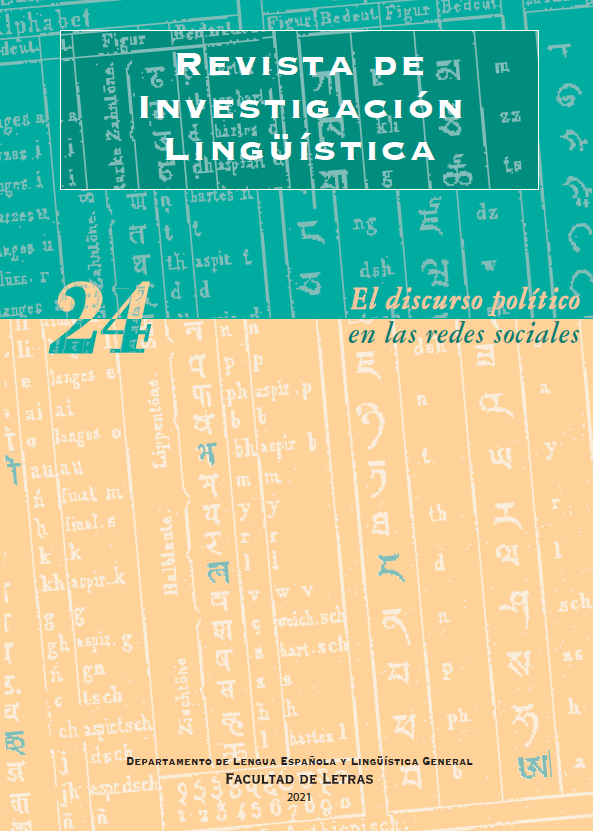Routine formulas at the service of the speech act of reproach: the case of «zapatero, a tus zapatos»
Abstract
The main goal of this paper is to analyse the routine formulas that —contrary to the lexicographical information given about this group of phraseological units— may fulfil complex expressive-directive functions as in the case of the speech act of reproach. In order to reach do such thing, we will focus on the formula zapatero, a tus zapatos for two main reasons: a) the functional values that are attached to this expression in the dictionaries exclude the expressive component of the acts that are conveyed through this expression, and b) there is a general opinion according to which the expression in question is a proverb and not a routine formula, a thesis that we will try to refute hereby.
Downloads
-
Abstract525
-
PDF (Español (España))750
References
ALVARADO ORTEGA, María Belén (2008): Las fórmulas rutinarias en el español actual. Tesis doctoral, Universidad de Alicante. En línea: [Consultado: 10/05/2019].
BROWN, Penelope y Stephen LEVINSON (1978): «Universals in language usage: Politeness phenomena», en Esther Goody (ed.), Questions and politeness. Strategies in Social interaction, Cambridge, Cambridge University Press, pp. 56-289.
BROWN, Penelope y Stephen LEVINSON (1987): Politeness. Some universals in language usage, Cambridge, Cambridge University Press.
CARRETERO, Marta, Carmen MAÍZ-ARÉVALO y M.ª Ángeles MARTÍNEZ (2015): «An analysis of expressive speech acts in online task-oriented interaction by university students», Procedia - Social and Behavioural Sciences, 173, pp. 186-190.
CASARES, Julio ([1950] 1992): Introducción a la lexicografía, Madrid, Consejo Superior de Investigaciones Científicas.
CDE = DAVIES, Mark: Corpus del Español (Web/Dialects). En línea: <https://www.corpusdelespanol.org/web-dial/> [07/03/2021].
CORPAS PASTOR, Gloria (1996): Manual de la Fraseología española, Madrid, Gredos.
CREA = REAL ACADEMIA ESPAÑOLA: Corpus de Referencia del Español Actual. En línea: <http://corpus.rae.es/creanet.html> [07/03/2021].
DDEE = CANTERA ORTIZ DE URBINA, Jesús (2011): Diccionario de dichos y expresiones del español. Su interpretación al alcance de todos. Madrid, Abada Editores.
DDFH = BUITRAGO, Alberto (2007): Diccionario de dichos y frases hechas. Madrid, Espasa.
DEC = MARTÍN SÁNCHEZ, Manuel (1997): Diccionario del español coloquial (Dichos, modismos y locuciones populares). Madrid, Tellus.
DFDEA = SECO, Manuel, Olimpia ANDRÉS y Gabino RAMOS ([2004] 2009): Diccionario Fraseológico Documentado del Español Actual. Locuciones y modismos españoles. Madrid, Aguilar Lexicografía.
DFEM = VARELA, Fernando e Hugo KUBARTH ([1996] 2004): Diccionario Fraseológico del Español Moderno. Madrid, Gredos.
DRAE 2014 = REAL ACADEMIA ESPAÑOLA (2014): Diccionario de la lengua española, 23.ª ed., Madrid, Espasa.
EsTenTen18 = Spanish Web 2018. En línea: <https://app.sketchengine.eu/#dashboard?corpname=preloaded%2Festenten18_fl5> [26/12/2020].
GDFH = LAROUSSE (2001): Gran Diccionario de Frases hechas. Barcelona, SPES Editorial.
GUIRAUD, Nadine et al. (2011): «The face of emotions: a logical formalization of expressive speech acts» en Kagan Tumer, Yolum Pinar Yolum, Liz Sonenberg y Peter Stone (eds.), Proc. Of 10th Int. Conf. On Autonomous Agents and Multiagent Systems (AAMAS), pp. 1031-1038.
GÜNTHER, Susanne (1996): «The prosodic contextualization of moral work: an analysis of reproaches in ‘why’-formats» en Elizabeth Couper-Kuhlen y Margret Selting (eds.), Prosody in conversation: Interactional studies, Cambridge, Cambridge University Press, pp. 271-302.
HAVERKATE, Henk (1990): «A speech act analysis of irony», Journal of Pragmatics, 14, pp. 77-109.
JAKONEN, Tepp (2016): «Managing multiple normativities in classroom interaction: Student responses to teacher reproaches for inappropriate language choice in a bilingual classroom», Linguistics and Education, 33, pp. 14-27.
MARGUTTI, Piera (2011): «Teachers’ reproaches and managing discipline in the classroom: when teachers tell students what they do ‘wrong’», Linguistics and Education, 22, pp. 310-329.
SEARLE, John ([1969] 2001): Actos de habla, Madrid, Cátedra.
SEARLE, John (1975): «Indirect speech acts» en Peter Cole and Jerry L. Morgan (eds.), Syntax and Semantics, Speech acts, San Diego, Academic Press, vol. III, pp. 59-82.
SEARLE, John (1976): «A classification of illocutionary acts», Language in Society, 5, pp. 1-23.
SEARLE, John (1979): Expression and meaning. Studies in the Theory of Speech Acts. Cambridge, Cambridge University Press.
SEARLE, John y Daniel VANDERVEKEN (1985): Foundations of illocutionary logic. Cambridge, Cambridge University Press.
TROSBORG, Anna (1995): Interlanguage pragmatics: requests, complaints and apologies. Berlin, Walter de Gruyter.
TULIMIROVIĆ, Bojana (2021a): Las fórmulas fraseológicas de reproche en español. Tesis doctoral, Universidad de Granada. En línea. <https://digibug.ugr.es/handle/10481/67819?locale-attribute=fr> [25/04/2021].
TULIMIROVIĆ, Bojana (2021b): «El tratamiento lexicográfico de las fórmulas rutinarias del reproche» en M.ª Águeda Moreno Moreno y Marta Torres Martínez (eds.), Investigaciones léxicas. Estados, temas y rudimentos, Barcelona, Octaedro, pp. 577-588.
VALLEJO ZAPATA, Víctor Julián (2011): «El reproche y el silencio vistos a la luz de la teoría de la cortesía: análisis pragmalingüísticos de Diatriba de amor contra un hombre sentado de Gabriel García Márquez», Íkala, Revista de lenguaje y cultura, 16 (29), pp. 45-65.
VALLEJO ZAPATA, Víctor Julián (2021): Caracterización de la fuerza ilocucionaria múltiple en el marco de la teoría de los actos de habla. Tesis doctoral, Universidad de Antioquia. En línea: <http://bibliotecadigital.udea.edu.co/handle/10495/19283> [09/09/2021].
Copyright (c) 2022 Journal of Linguistic Research

This work is licensed under a Creative Commons Attribution-NonCommercial-NoDerivatives 4.0 International License.
The works published in this magazine are subject to the following terms:
1. The Publications Service of the University of Murcia (the publisher) preserves the economic rights (copyright) of the published works, and favors and allows the reuse of same under the license of use indicated in point 2.
2. The papers are published in the electronic edition of the magazine under a Creative Commons Attribution-NonCommercial-NoDerivative 3.0 Spain license (legal text). Papers may be copied, used, disseminated, transmitted and publicly exhibited if the following requirements are met: i) The authorship and the original source of its publication (magazine, editorial and URL of the work) must be cited; ii) The works cannot be used for commercial purposes; iii) The existence and specifications of this user license must be explicitly mentioned.
3. Self-archiving conditions. Authors can electronically disseminate pre-print versions (version before being evaluated) and / or post-print versions (version evaluated and accepted for publication). This makes possible its circulation and diffusion earlier and with it a possible increase in its citation and reach among the academic community. RoMEO color: green.









